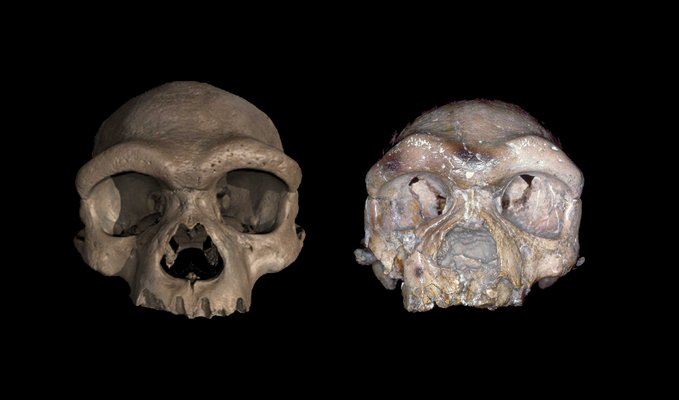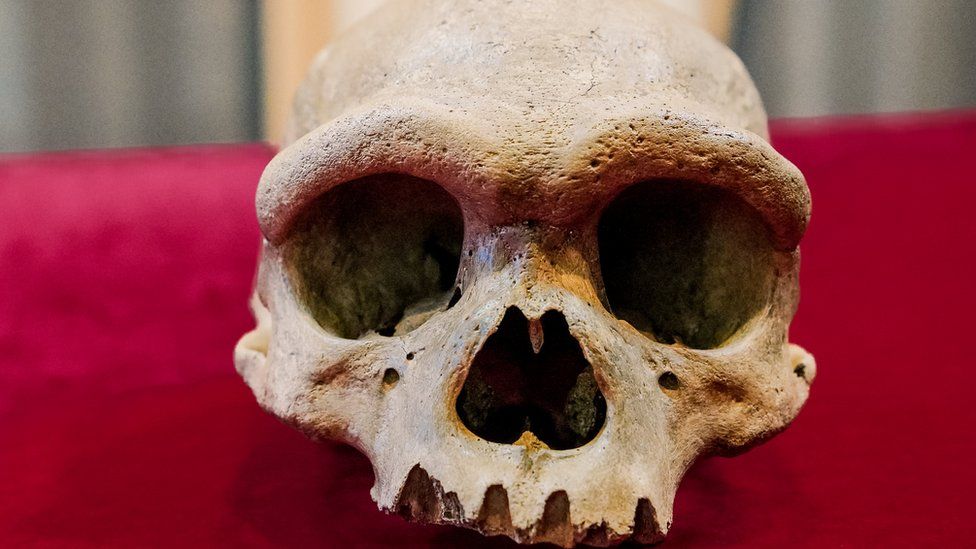
The reported discovery of a new hominin species from China created a lot of buzz last week. Its discoverers—paleoanthropologists Xijun Ni, Qiang Ji, Chris Stringer, and their colleagues—say that a skull discovered near Harbin, in northeast China, has a combination of features that's so different from Neanderthals, Denisovans, and Homo sapiens that it must be a separate species. The researchers have named the find Homo longi after the river where the skull was unearthed. Based on statistical comparisons of the skull's measurements with skulls from other hominins, Ni and colleagues say that Homo longi is a sister species to Neanderthals, Denisovans, and us.
But that's still very much open for debate among paleoanthropologists, and the debate raises questions about how (or whether) we should draw lines between hominin species.
Meet the Harbin skull
Based on uranium-series dating, the Harbin skull lay buried for at least 146,000 years, but it's in remarkably good shape. Fossil hominin skulls often end up crushed or warped by the weight of the earth above them after many millennia in the ground, but the Harbin skull isn't distorted at all. It's also intact, even though the only tooth still attached is a left molar. That's unusual in itself, because teeth usually are the most common hominin fossil finds.
The skull has a wide face with small, flat cheekbones, set underneath the dome of the skull. The face doesn't stick out in front of the skull like an australopithecine or a modern ape, although the upper jaw still protrudes a bit. Large eye sockets sit beneath heavy, curving brow ridges. The braincase is as large as a modern person's, but it's long and low rather than high and round. The jaw once held large molars that look like they belong to an older member of our family tree—or a Denisovan.
Each of those individual features has been seen before in other hominin species. Species like Homo erectus and Homo heidelbergensis have long, low cranial vaults like the Harbin skull. But they also both have a bulge of bone called an occipital torus (or occipital bun) at the back of their skulls. Long, low skulls and occipital buns are both usually signs of an older branch of the human family tree: traits inherited from our last common ancestor with modern apes, rather than new ones evolved as our paths diverged. The Harbin skull's heavy brow ridges, protruding upper jaw, and big, robust molars are also considered archaic features.
Old and new
On the other hand, a relatively flat face that sits just beneath the brows, instead of sticking out front, is a hallmark of modern humans. So are the skull's small, low cheekbones and its large cranial capacity (about 1,420 milliliters, if you're counting). Then again, the Harbin skull is just impressively large in general. As Ni and colleagues wrote, "its enormous overall size sets it apart from nearly every other fossil," so we can't be sure how big its braincase was in relation to its body size.
According to Ni and colleagues, anthropologists have never seen all of those features together in this exact combination until the Harbin skull. It's what paleoanthropologists call a mosaic, with some traits that look like they come from older lineages and some that seem more like ours.
Mosaics are common in the hominin family tree. But the important question about the Harbin skull is whether its combination of features is really the trademark of a whole separate species, related to—but distinct from—Neanderthals, Denisovans, and us.
Paleoanthropologists have unearthed several Neanderthal skulls, but the only Denisovan fossils known so far are a few teeth, a finger bone, and a single skull fragment from Denisova Cave in Siberia as well as a jawbone from Xiahe in northern China. In other words, we don't have many examples to compare the Harbin mandible to if we want to say whether it looks like a Denisovan skull. There's no shortage of Homo sapiens skulls to look at, of course, and it's clear that, whatever the Harbin skull once was, it didn't belong to a member of our species (spoiler alert: depending on how we define our species).
Looking at skulls from modern humans, however, should remind us how much diversity in size, shape, and appearance can exist within a species, especially one that's adapted to live in environments all over the world. The Harbin cranium could be well within the normal range of diversity for Denisovans, who were also a very widespread species, or it could be something completely different. We just don't have enough information about Denisovan skulls to know yet.
Denisovan or Homo longi?
When Ni and colleagues did their statistical analysis, they pointed out that the Harbin skull fell into a group along with the 160,000-year-old Denisovan mandible from Xiahe, which anthropologists identified based on proteins still preserved within it. In other words, Harbin and Xiahe probably belong to the same species or to closely related species. Meanwhile, the one molar still attached to the Harbin skull looks remarkably like two Denisovan molars from Denisova Cave in Siberia.
The Harbin skull also fits in well with a 200,000-to-260,000-year-old skull found in Dali County in northwestern China, a roughly 300,000-year-old skull found in Hualong Cave in eastern China, and a 260,000-year-old skull from Jinniushi (sometimes spelled Jinniushan) Cave in China. All three of those fossils have been described as looking like something in between Homo erectus and modern humans.
It's possible—although still mostly fodder for speculation—that all or some these fossils, along with some from Taiwan and northern China whose molars look an awful lot like the Xiahe ones, could turn out to be an East Asian group of Denisovans.
That would still make the Harbin cranium an important find. It doesn't have to represent a brand-new-to-science species to be a valuable piece of a mostly unwritten chapter of our evolutionary story. Denisovan remains are still extremely scarce, and it's increasingly clear that East Asia was an important place for our ancestors during the Early and Middle Paleolithic.
Then again, at least some of the Asian hominin fossils might also turn out to be, as Ni and colleagues claim, a distinct species. Only more evidence can clear up that debate, and Ni and colleagues acknowledge that in one of their recent papers. "More mandibular specimens for the Harbin population, or cranial specimens corresponding to the Xiahe mandible, will test how close the Harbin and Xiahe humans are morphologically," they wrote, "while new genetic material will test the relationship of these populations to each other and to the Denisovans."
DNA, proteins, and other evidence
DNA testing would provide the clearest answer. At one time, biologists classified species and figured out their relationships based on whether things looked alike. Now, the question often comes down to genetics. For a lot of older hominin species, of course, that's impossible; no australopithecine or early Homo DNA survives, so paleoanthropologists are stuck with how the bones look. But we do have Neanderthal, Denisovan, and of course Homo sapiens genomes. If ancient DNA can be retrieved from the Harbin cranium, most of the debate could be resolved.
Even without DNA, there may be another option. The genes in DNA code for proteins, which are the building blocks of an organism. And proteins may survive in ancient bones longer than DNA. Back in 2019, University of Copenhagen anthropologist Fredo Welker told Ars Technica that proteome analysis like the kind that identified Xiahe as a Denisovan could be the key to discovering more Denisovan fossils, already unearthed and sitting in museum collections.
Of course, the best ancient DNA samples in the world won't resolve the much more complicated question of how we should define a species in the first place—a debate Homo longi just walked right into the middle of.
Splitters, lumpers, and hybrid fitness
Even with whole genomes to compare, scientists don't always agree on what counts as a species, a subspecies, or just a diverse population. Classically, if two organisms can't interbreed, they count as separate species. We know that Neanderthals, Denisovans, and Homo sapiens spent most of the Early and Middle Paleolithic hooking up on several continents, and the evidence still lingers in our genes. And predictably, some anthropologists argue that we should call Neanderthals and Denisovans subspecies of Homo sapiens if we're going to call them anything different at all.
According to paleoanthropologist John Hawks, when members of different species have a hybrid baby, that offspring usually doesn't have a good chance of reproducing. Some hybrids, like mules, are sterile, while others may face other challenges. The amounts of Neanderthal and Denisovan DNA in modern genomes, Hawks told Ars, "suggest that hybrids between these lineages of humans were common and successful. That's what we would expect if they were not speciating."
Others argue that there's enough genetic and physical difference among the three groups to consider them separate species.
Comparison between the Denisovan genome recovered from a fossil fragment at Denisova Cave and fragments of Denisovan DNA present in modern human genomes suggests that the two came from distinct populations that had split apart around 300,000 years ago. That means they "therefore could be almost as different, one from the other, as Neanderthals from Denisovans," anthropologist Jean-Jacques Hublin of the Max Planck Institute for Evolutionary Anthropology told Ars in 2019. (Analysis of Neanderthal and Denisovan genomes suggest that the two sister species diverged between 445,000 and 473,000 years ago.)
If we consider Neanderthals and Denisovans separate species, should what we're calling Denisovans actually be two or three separate species? Ironically, that may be the best argument in favor of Homo longi as a new species.
So where does that leave Homo longi? Until we have more evidence, it's difficult to tell. And it's more likely that new evidence will decide where the debate can really begin.
The Innovation, 2021 DOI: 10.1016/j.xinn.2021.100130 (About DOIs).



3175x175(CURRENT).thumb.jpg.b05acc060982b36f5891ba728e6d953c.jpg)

Recommended Comments
There are no comments to display.
Join the conversation
You can post now and register later. If you have an account, sign in now to post with your account.
Note: Your post will require moderator approval before it will be visible.